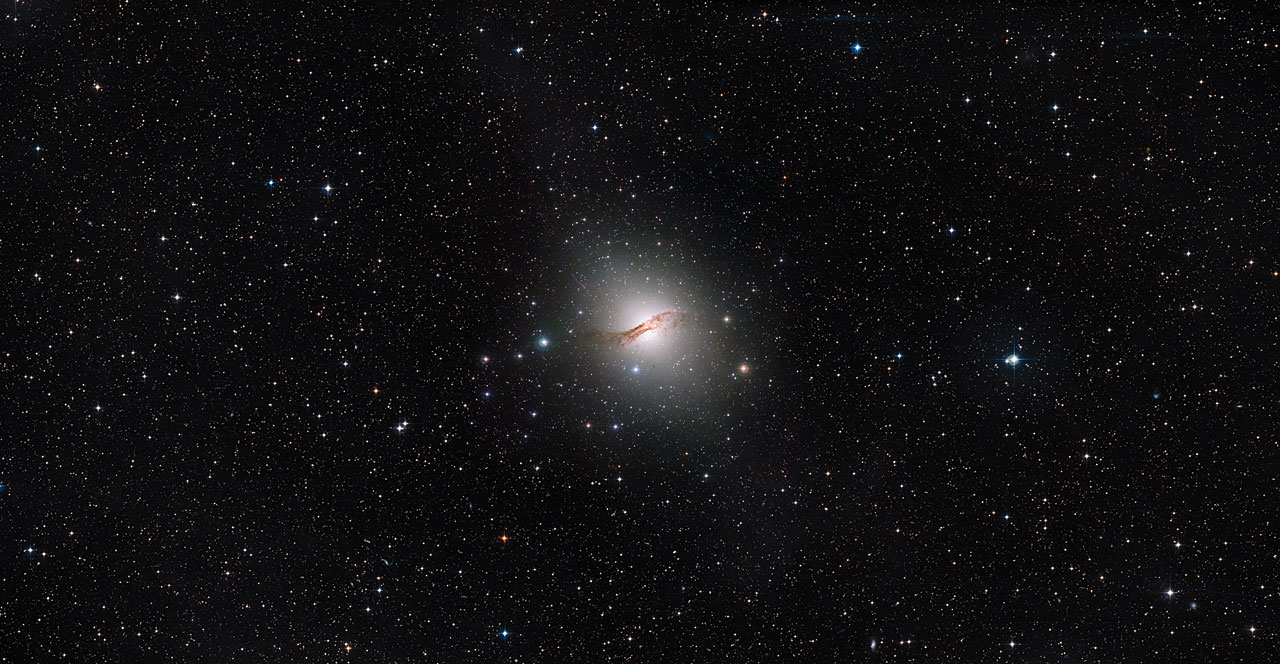 This huge elliptical
galaxy NGC 5128 (also known as Centaurus A) is the closest such galaxy
to the Earth, at a distance of about 12 million light-years.
Observations with ESO’s Very Large Telescope in Chile have discovered a
new class of “dark” globular star clusters around this galaxy. These are
marked in red. Normal globulars are marked in blue and globulars
showing similar properties to dwarf galaxies are in green.
This huge elliptical
galaxy NGC 5128 (also known as Centaurus A) is the closest such galaxy
to the Earth, at a distance of about 12 million light-years.
Observations with ESO’s Very Large Telescope in Chile have discovered a
new class of “dark” globular star clusters around this galaxy. These are
marked in red. Normal globulars are marked in blue and globulars
showing similar properties to dwarf galaxies are in green.Credit: ESO/Digitized Sky Survey. Acknowledgement: Davide De MartinAstronomers studying the globular star clusters orbiting the giant elliptical galaxy Centaurus A (NGC 5128) have stumbled upon a fascinating discovery — the clusters are too massive.
What does this mean? Well, it could be that each of the dozens of
clusters studied are packed with dark matter or may even by hiding a
massive black hole, but neither of the explanations make any sense.
Globular star clusters are ancient ensembles of thousands of stars that
can be found orbiting galaxies like our Milky Way. Their study is
critical to help us understand how galaxies on the whole evolve as the stars they are known to contain are often as old as the galaxies they orbit.
"Globular clusters and their constituent stars are keys to
understanding the formation and evolution of galaxies. For decades,
astronomers thought that the stars that made up a given globular cluster
all shared the same ages and chemical compositions — but we now know
that they are stranger and more complicated creatures," said Matt Taylor, a PhD student at the Pontificia Universidad Catolica de Chile, Santiago, Chile, and lead author of the study.
Using the FLAMES instrument on the ESO's Very Large Telescope
at the Paranal Observatory in Chile, Taylor and his team surveyed 125
of the around 2,000 globular clusters in orbit around Centaurus A and
gauged their masses. Usually, the mass of a globular cluster can be
derived by measuring their brightness. The brighter the cluster, the
more stars it has and the more massive it is.
As expected, for the most part, this brightness-mass relationship held
true. But something strange started to emerge from the data — some of
the clusters were more massive than the brightness data suggested.
What's more, the more massive these strange clusters were, the greater
the fraction of their mass was dark.

Naturally, the researchers' suspicions are focusing on these clusters amassing a reservoir of dark matter.
But globular star clusters are not thought to contain significant
quantities of invisible stuff. Perhaps, therefore, these islands of
stars have massive black holes in their cores, or maybe a massive
graveyard of other stellar corpses, like the burnt-out husks of stars
like neutron stars? For now, where this extra baggage comes from remains
mystery.
"Our discovery of star clusters with unexpectedly high masses for the
amount of stars they contain hints that there might be multiple families
of globular clusters, with differing formation histories. Apparently
some star clusters look like, walk like, and smell like run-of-the-mill
globulars, but there may quite literally be more to them than meets the
eye," added co-author Thomas Puzia, also at the Pontificia Universidad
Catolica de Chile.
To widen the search, the researchers are now carrying out a survey of
other globular clusters around other galaxies in the hope of finding
more of these mysterious "dark clusters."
"We have stumbled on a new and mysterious class of star cluster! This
shows that we still have much to learn about all aspects of globular
cluster formation. It's an important result and we now need to find
further examples of dark clusters around other galaxies," concluded
Taylor.
Source: ESO
This article was provided by Discovery News.

No comments:
Post a Comment